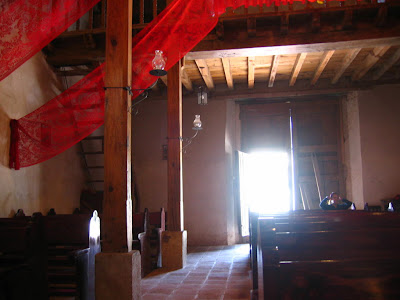Quetzaltenango is more commonly called Xela (pronounced shay-lah), short for Xelaju (shay-lah-HOO), the ancient name for the city. 65% of the regional population is indigenous, so it's easy to see why they politely ignore the Spanish name for the town, preferring the traditional Mayan. The native people here have a separate language, unrelated to Spanish, and a fascinating culture all their own. I'll talk more about the Quiche (or K'iche')(pronounced key-chay) people and their wonderful dress in a later post.
Our moonlit path through the mountains, past volcanic peaks wreathed in cloud and woodsmoke, was the first hint of the cold and the dust we'd experience for the rest of our stay in Guatemala. This region is not tropical at all, much to my surprise, but high-altitude, almost desert terrain. At night, the temperature typically falls below forty degrees fahrenheit- yet by midday it can easily reach seventy degrees.
We were there in dry season, when there is sometimes no rain for months (we didn't see a drop of rain the whole time we were in Guatemala, except on the short drive to the airport going home). Which explains all the dust.
And despite the cool evening temperatures, we discovered the hotels in Xela are generally not heated. Instead, the rooms come equipped with the latest in handwoven, heavy wool blanket technology, draped along the foot of each bed for those extra chilly nights. Thankfully the showers ran very hot water- in most rooms, on most days, depending how far your room was from the hot water tank.
As a regional capital, Xela is larger and more formal than some of the other towns we saw in Guatemala. It features a beautiful plaza with municipal buildings (including the mayor's office), banks and restaurants around a central square.
Monument in Central Plaza:

Street scene around Central Plaza:

Side street where our hotel was located:

Cathedral in Central Plaza at night:

We spent two full clinic days in Xela, and stayed at the very comfortable Hotel Modelo each night for the entire week.
The other two clinic days we worked in a nearby suburb, called Salcaja (sal-cah-HAH), just a twenty-minute drive from Xela. Salcaja is small-townish and off the beaten path for tourists. But it has two features definitely worth the side trip, in case you find yourself in the neighborhood someday:
There is a wonderful weekend market, full of an extraordinary array of produce brought in by local people, who come decked out in the beautiful woven material for which Salcaja is famous. It was clear they don't see too many tourists in these parts, because the locals stared at us openly.



Salcaja is also famous for its Church of San Jacinto, also called the Church of the Conquistador. It was the first church built in Central America, in 1524, and is still intact. Unfortunately it's not generally open to the public, except on special occasions. But someone knew someone who knew someone who keeps the key (remember this is a small town), so we were lucky enough to be shown the inside, as a special treat.



Scenes around Salcaja:




Stay tuned for scenes from our wild and wooly days in clinic.....
No comments:
Post a Comment